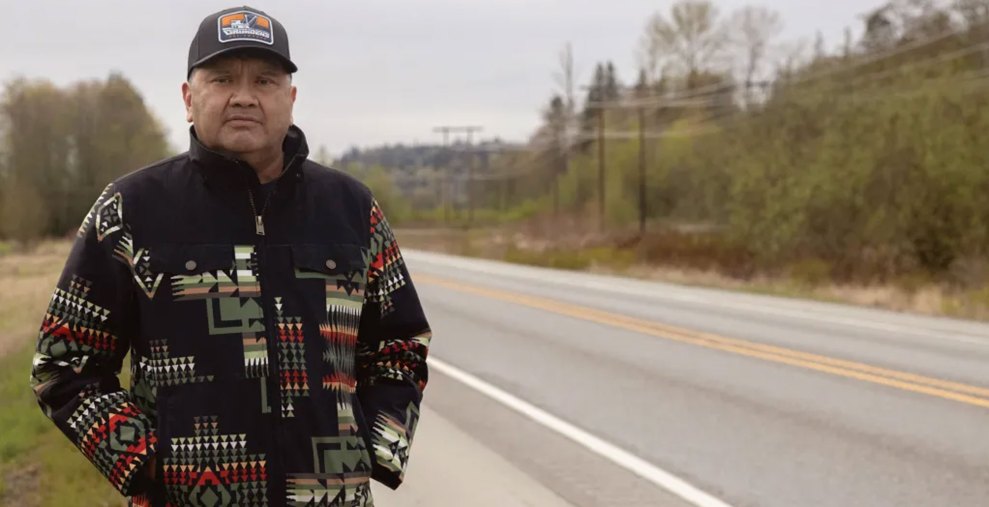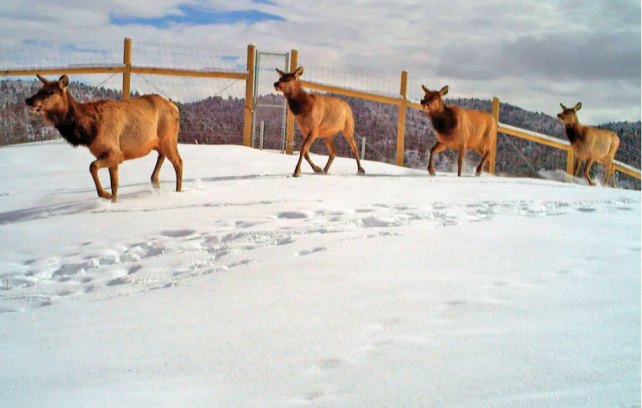
Scott Schuyler, a member of the Upper Skagit Indian Tribe and its natural resources and cultural policy representative, stands by the site of the future wildlife crossing in Skagit Valley, Washington.Flynn Rodriguez/High Country News
This story was originally published by High Country News and is reproduced here as part of the Climate Desk collaboration.
The North Cascades elk herd is a cluster of some 1,600 animals whose domain, like so many habitats, is riven by a highway. From 2012 to 2019, Washington state records show, at least 229 elk were killed by cars along a stretch of State Route 20 in the Skagit Valley. The situation imperils humans, too: In 2023, a motorist died after swerving around an elk into a telephone pole.
“My own nephew had an elk collision, and I’ve nearly had collisions myself over the years,” said Scott Schuyler, a member of the Upper Skagit Indian Tribe, who is also the tribe’s natural resources and cultural policy representative. “We have an obligation to protect our neighbors and ourselves and these animals.”
To many observers, the solution has long been clear: a wildlife bridge, flanked by fencing. But building such a structure would cost around $8.5 million, a daunting expense. “There didn’t seem to be any money out there on the horizon that could make this happen,” said Jennifer Sevigny, a biologist with the nearby Stillaguamish Tribe of Indians, which co-manages the elk herd.
That changed in November 2021, when Congress passed the Bipartisan Infrastructure Law—a package that included the Wildlife Crossings Pilot Program (WCPP), a grant initiative that would distribute $350 million over five years to states, Native tribes and other entities for animal-friendly infrastructure. Although Sevigny knew the competition for grants would be fierce, she submitted a proposal for an elk bridge when the program launched in 2023. “Honestly, I didn’t think we were going to get it,” she said.
When the recipients of the first $110 million in grants were announced in December 2023, however, the Stillaguamish was among them. Once the grant agreement is finalized, the tribe will partner with the Upper Skagit to convene biologists and engineers to design the bridge, which is expected to take four years to construct.
The Skagit Valley overpass wasn’t the only tribal winner: Of the 10 Western wildlife crossing projects selected for the initial round of WCPP funding, four were Native-led. “It was really awesome to see that (experience) come to fruition,” said Shailyn Wiechman, connectivity coordinator at the Native American Fish and Wildlife Society and a member of the Chippewa-Cree Tribe of the Rocky Boy’s Indian Reservation. But tribal-led connectivity projects on and adjacent to reservations still face obstacles—and money remains a big one.

Elk use a crossing over Colorado’s Highway 160 as it passes through the Southern Ute Tribe’s land. Tribal biologists used years of deer and elk research to help determine the crossing’s location.
Aran Johnson/Southern Ute Wildlife via High Country News
Tribes have long been among the staunchest advocates of wildlife crossings. When Montana declared its intent to widen US 93 on the Flathead Indian Reservation in the early 1990s, the Confederated Salish and Kootenai Tribes objected: The road, the tribes declared, should “respond to and be respectful of the land and the Spirit of Place.” State and federal engineers, in consultation with tribal officials, eventually included fences and around 40 wildlife crossings—underpasses and a capacious overpass—in the highway’s reconstruction. Roadkill plummeted, and the passages allowed grizzly bears, deer and other species to safely traverse the highway.
More recently, the Burns Paiute Tribe in Oregon has collected animal movement and collision data on Highway 20, which bisects the tribe’s traditional homeland, and the Blackfeet Nation has partnered with nonprofits and researchers to devise a plan for reducing roadkill on its lands. In 2022, the state of Colorado completed a wildlife overpass and underpass where Highway 160 passes through Southern Ute Tribe land—passages whose locations were guided by years of deer and elk research by tribal biologists. The tribe contributed $1.3 million toward the $12 million passages, which were used by more than 1,300 deer and 600 elk in their first four months.
When Secretary of Transportation Pete Buttigieg kicked off the Wildlife Crossings Pilot Program in April 2023, he did so in New Mexico on the Santa Ana Pueblo, which hopes to build wildlife crossings on nearby Interstate 25 and Highway 550. The Santa Ana and other tribes, Buttigieg declared over the rumble of I-25 traffic, had “helped lead the rest of the country” in establishing crossings.
But the program’s details offered reason for concern. While successful applicants for the WCPP receive up to 80 percent of the funding for chosen crossings, they’re required to cover the remaining cost. Few Native tribes are so cash-flush, and in a 2022 letter to the US Department of Transportation, environmental groups urged Buttigieg to waive the matching requirement for tribes “as a matter of equity.” But the agency didn’t budge; in an email, a department spokesperson said that the program was “subject to federal share requirements” in US statutes, and that the agency was working with tribes to identify opportunities for flexibility.
Wiechman, who provided technical support to tribal applicants, observed that tribes are accustomed to “Frankensteining” money together, and the four tribes that secured WCPP grants met the matching requirement with the help of funds from partners and other federal programs. In New Mexico, the Mescalero Apache Tribe received nearly a half-million dollars to evaluate future crossings on I-70; in Washington, the Puyallup Tribe of Indians got $216,000 to plan passages along a state highway. And the Salish and Kootenai were granted $8.6 million to construct another overpass on Highway 93. “We have tribal sovereignty, we have treaties, and we use those political points to be able to push these projects forward,” said Whisper Camel-Means, a member of the Salish and Kootenai tribes and the manager of their Division of Fish, Wildlife, Recreation, and Conservation.
The Stillaguamish met the matching requirement by working with a couple that owns five parcels of land, totaling 143 acres and worth $1.2 million, on either side of the proposed overpass. The couple has been purchasing land to protect elk for the past decade, and the tribe had discussed a crossing structure with them long before the grant was announced. While this was certainly a clever solution, it meant that both the tribe and private landowners had to contribute to healing the wound created by a state-owned highway.

Danielle Austin and Aran Johnson, wildlife biologists for the Southern Ute Tribe, prepare collars for their elk research in 2013.
Jeremy Wade Shockley/The Southern Ute Drum via High Country News
The matching requirement, said Wiechman, remains “an enormous barrier” for many tribes. Santa Ana Pueblo biologists, on whose land Buttigieg announced the program, have spent years studying the risks nearby highways pose to deer, bears, cougars and other species. But the New Mexico Department of Transportation chose not to propose passages adjacent to the pueblo in its own WCPP grant application, and the tribe was unable to muster matching funds in time—though, according to Glenn Harper, the Santa Ana’s range and wildlife division manager, it plans to apply this year.
Tribal members and advocates hope that future grant cycles will exempt tribal-led projects from the matching requirement (a change that could require tweaking the federal code) and prioritize species that have cultural importance to tribes. The significance of migratory wildlife to many tribes, along with the safety problems that plague Bureau of Indian Affairs roads, makes Native lands prime candidates for crossings. And since state and federal highways have fragmented tribal lands for generations, Native leaders argue that it is only just that governments prioritize their reconnection.
“In our history and our culture, we’re taught to leave things better than what we inherited, and to repair and restore what you can,” Scott Schuyler said. “This is the continuation of our moral and historical obligation.”
This story is part of High Country News’ Conservation Beyond Boundaries project, which is supported by the BAND Foundation.















